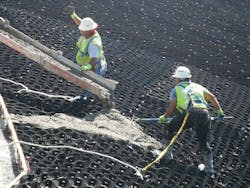Going Hardcore
The city of Chicago’s McCook Reservoir originally was authorized in the Water Resources Development Act of 1999 and is a key component to Chicago’s ongoing Tunnel and Reservoir Plan, more commonly known as the Chicago Deep Tunnel Project. This reservoir is one of many that will store excess combined sewer overflow (CSO) water from the Mainstream and Des Plaines deep tunnel systems until floodwater levels recede. The stored water then will be pumped to the Stickney Water Reclamation Plant for treatment and appropriate discharge. A distribution tunnel system to empty the reservoir has been completed, with the exception of the final connection to the reservoir.
Permanent erosion protection was necessary for McCook Quarry’s unfinished limestone embankments, as limestone is prone to chemical and mechanical weathering. The active quarry, operated by Vulcan Materials, will become the McCook Reservoir, owned by the Metropolitan Water Reclamation District, upon abandonment. The massive quarry/reservoir has average depths of 300 ft, is approximately 1.75 miles in diameter and provides 10 billion gal of additional combined CSO storage to minimize flood damage during periods of peak flows to the city of Chicago and numerous surrounding communities.
The 105-ft-long slopes above the quarry face required a system that would be low maintenance and stable at 2H:1V slope angles. A major site-specific challenge was installing an erosion control product on a steep, long slope with a 300-ft drop at the bottom. Installation of the chosen product also would need to be performed by hand, as machines were not safe on the embankment.
Slope Protection Solution
After evaluating several hard-armor systems, the U.S. Army Corps of Engineers (USACE) and the Metropolitan Water Reclamation District selected Presto Geosystems’ Geoweb cellular confinement system, a 3-D geocellular system for confining infill material with crushed aggregate and concrete infill. Lightweight concrete infill (maximum unit weight 115 pcf, 28-day compressive strength in excess of 2,500 psi) was specified in the areas where the majority of the water would enter the reservoir, while aggregate infill (1.5-in. maximum particle size) was used in areas that would only be affected by fluctuating water levels. In both cases, a non-woven geotextile was placed below the Geoweb panels. The system met the installation requirements in the restricted area, along with the requirement for minimal long-term maintenance.
Overcoming Challenges
Several challenges were met in the design of the project. USACE required a safety factor of 1.5 on the slopes, two types of infill were used, and slope angles varied from 1.5H:1V to 2H:1V. Additionally, a 12-in. snow load was required to be incorporated into the calculations.
In order to avoid over-design and increased costs on the long, relatively steep slopes, field stake resistance testing was done. This allowed Presto engineers to use actual site data in the calculations rather than make conservative assumptions, helping to keep project costs down while still accounting for the required snow load and achieving the required safety factor.
In the end, two different design recommendations were provided. For aggregate-infilled slopes at 2H:1V, 24-in.-long, ½-in.-diameter rebar with ATRA stake clips was spaced in a three-cell-by-three-cell pattern (each cell is approximately 1 ft by 1 ft). For concrete-infilled slopes at 1.5H:1V—the worst case scenario—30-in. stakes were required in a three-cell-by-two-cell pattern.
Keeping on Track
The Presto Geoweb cellular confinement system had some system installation components—ATRA keys, ATRA clips for the anchors and the ability to use a GAD attachment with a Hilti air hammer—that were attractive to Schwartz Eng. “These features drastically cut our installation costs while giving us the highest-performing finished product,” said an associate at Schwartz Eng. who worked on the project.
“The Geoweb system made sense on several fronts. It met installation requirements, required virtually no maintenance and provided long-term erosion protection of the challenging slopes,” said Dan Salsinger of Hanes Geo/Ero-Tex, the onsite manufacturer’s field representative and material supplier for the project.
“The sections were also quick and easy to connect with ATRA keys,” Salsinger added. “When you are talking about installing and infilling sections on steep slopes up to 100 ft long, the ease of installation was a huge factor in keeping the project on schedule and budget.”
The ATRA keys, used for the Geoweb section connection both side to side and end to end, also are three times stronger than the alternate connection method of stapling and provide corrosion resistance to ensure long-term performance.
Embankment Protection
The Geoweb system with aggregate and concrete infill provided a flexible, hard-armored, long-term slope cover. For the aggregate-covered portions of the reservoir, the cellular confinement system allowed for the use of much smaller aggregate than would have been required without confinement, simplifying installation. On the concrete-filled portions, the use of the geocellular system eliminated the need for additional reinforcement and formwork, as the cells serve as the form. Additionally, the large number of joints created by the cell walls created a flexible concrete mat that is resistant to cracking with subgrade deformation.
Download: Here


